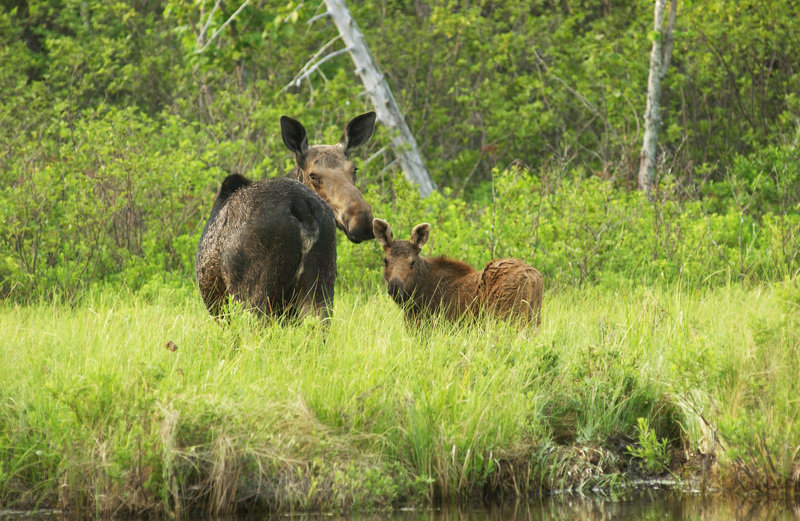So you want to see a moose.
Maybe you’re a photographer, or perhaps you were lucky enough to get a moose permit and you want to scout some areas, or maybe you’re headed to northern Maine on vacation and you want to see a moose.
Where should you go?
“The two things that you think about with moose is temperature and food,” said Doug Kane, a wildlife biologist with the Department of Inland Fisheries and Wildlife for 23 years. Kane’s office is on the shores of Moosehead Lake, and his region stretches north and west into prime moose area. Over his career, he has encountered thousands of moose.
“Moose get heat stressed very easily, and although August is a great month for people to come to places like Greenville for vacation, if they want to see a moose, it can be very difficult, as August can have some very hot days,” Kane said.
During this time of year, moose are reliant on water, looking for cooling relief from the day’s heat, as well as the aquatic vegetation.
“Moose are tied to the water, and if you can find the ponds that have aquatic plants which are high in sodium and other trace minerals, that’s where they are at,” Kane said.
“If you are willing to get off the road, we have hundreds of these backwoods ponds, and that’s one great place to be. The logistics are not always easy, you have to do some homework, take your atlas out, find where the ponds are,” said Kane, who adds that the north country is much more roaded now, allowing for easier access to many of these ponds.
As September starts, however, moose habits begin to change. Gone are the long days of bedding in the shade during the day and feasting in the water.
“Food, of course, is very critical,” Kane said. “As temperatures get lower and we have cooler nights, moose are feeding more and eating browse in the cuts, where there is regenerating forage. Moose love hardwoods like maples, willows and aspens.
“Moose seem to prefer cuts that are a couple of years old to six or seven years old. These have vegetation that is anywhere from a foot high to four or five feet high. Often there is a lot of it growing in the more open cuts like clear cuts or patch cuts or some of the more heavy partial harvests.”
Of course, some of the best areas to find moose are areas that have both of these features: ponds or slow-moving rivers near areas that were heavily logged in the past few years.
“If those clear cuts happen to be adjacent to water, that’s even better. It may be a larger stream or river that’s adjacent to some of the larger cuts — that can be a very good combination,” Kane said.
As the weather continues to get cooler, not only are moose less dependent on water for dealing with heat stress, but they are also entering the rut and beginning to pair up.
“Once the rut starts kicking in sometime in mid-September, things change and temperatures are cooler, cows are feeding more where there is good feed, trying to put on weight before winter,” said Kane. “Their water source may be quite a ways from the better food.”
“Right after the bulls shed their velvet (off the antlers), the rut activity increases,” he said. At this point, bull moose are looking to pair up with cows, and cows are busy feeding.
“Just before the peak of the rut, which is the last 10 days of September and the first few days of October, Moose begin to really, really thrash stuff. Some of these 4- to 7-year-old bulls really thrash the alders and it is very evident,” said Kane, who says you can see the damage along the sides of logging roads. At this point, some bulls are matched with cows, especially the mature bulls.
Kane notes that right before bulls match up with cows, it is one of the best times for calling moose. He uses a female call, which is often followed by a tending grunt by the bull.
“During that time, a savvy hunter can take an angle so they are going down wind of that animal, take a compass bearing and go directly in,” said Kane. “Some of the biggest bulls can be had that way, but you have to be good with your navigating making sure you are downwind, being quiet and being able to see them before they see you and get spooked.”
Because as Kane notes: “A cow will spook easier than a bull, and if the cow spooks, the bull is gone, because he is going with her.”
Mark Latti is a former public information officer for the Maine Department of Inland Fisheries and Wildlife and a registered Maine Guide. He can be reached at:
mlatti@gmail.com
Copy the Story Link
Send questions/comments to the editors.



Success. Please wait for the page to reload. If the page does not reload within 5 seconds, please refresh the page.
Enter your email and password to access comments.
Hi, to comment on stories you must . This profile is in addition to your subscription and website login.
Already have a commenting profile? .
Invalid username/password.
Please check your email to confirm and complete your registration.
Only subscribers are eligible to post comments. Please subscribe or login first for digital access. Here’s why.
Use the form below to reset your password. When you've submitted your account email, we will send an email with a reset code.